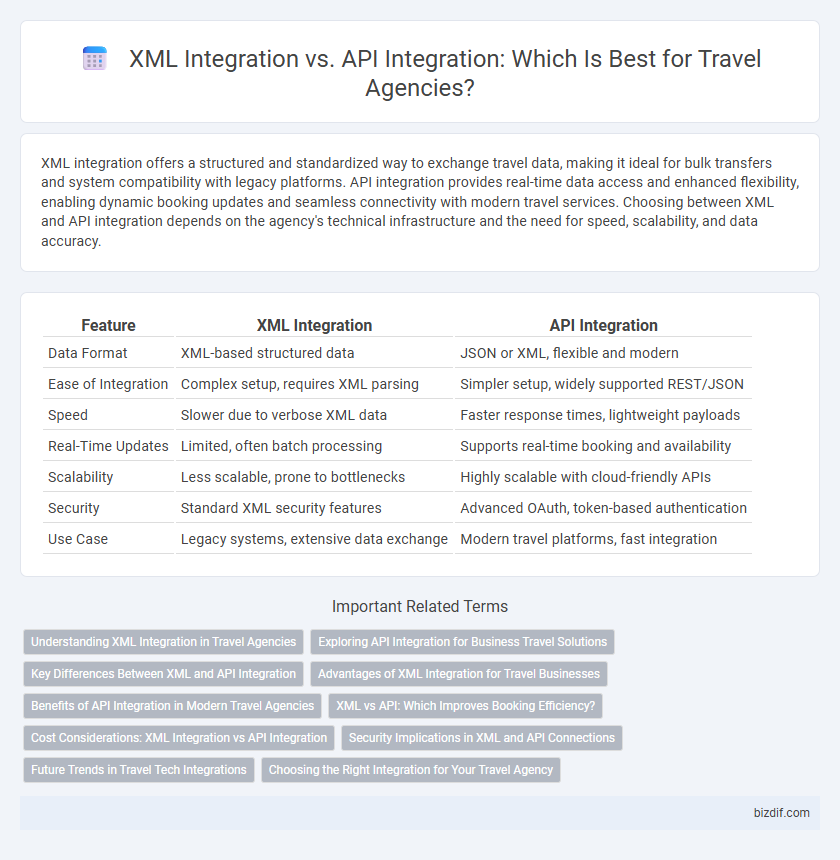XML integration offers a structured and standardized way to exchange travel data, making it ideal for bulk transfers and system compatibility with legacy platforms. API integration provides real-time data access and enhanced flexibility, enabling dynamic booking updates and seamless connectivity with modern travel services. Choosing between XML and API integration depends on the agency's technical infrastructure and the need for speed, scalability, and data accuracy.
Table of Comparison
| Feature | XML Integration | API Integration |
|---|---|---|
| Data Format | XML-based structured data | JSON or XML, flexible and modern |
| Ease of Integration | Complex setup, requires XML parsing | Simpler setup, widely supported REST/JSON |
| Speed | Slower due to verbose XML data | Faster response times, lightweight payloads |
| Real-Time Updates | Limited, often batch processing | Supports real-time booking and availability |
| Scalability | Less scalable, prone to bottlenecks | Highly scalable with cloud-friendly APIs |
| Security | Standard XML security features | Advanced OAuth, token-based authentication |
| Use Case | Legacy systems, extensive data exchange | Modern travel platforms, fast integration |
Understanding XML Integration in Travel Agencies
XML integration in travel agencies enables seamless data exchange between booking systems, suppliers, and customers by structuring information in a standardized format. This method facilitates real-time updates on availability, pricing, and reservations, improving operational efficiency and customer experience. XML's compatibility with legacy systems makes it a reliable choice for travel agencies managing diverse content sources and complex itinerary details.
Exploring API Integration for Business Travel Solutions
API integration offers real-time access to travel inventory, enabling seamless booking and dynamic pricing updates that XML integration often lacks. Leveraging RESTful APIs enhances data exchange efficiency for business travel solutions, supporting instant itinerary management and customized client experiences. Modern travel agencies benefit from API integration's scalability and faster transaction processing, optimizing operational workflows and improving customer satisfaction.
Key Differences Between XML and API Integration
XML integration relies on structured XML files exchanged between systems, enabling offline processing and batch updates, while API integration facilitates real-time data exchange through web services using protocols like REST or SOAP. APIs offer greater flexibility, faster responses, and improved scalability for dynamic travel booking systems, whereas XML suits legacy systems requiring standardized message formats. The choice impacts speed, interoperability, and ease of maintenance in travel agency software connectivity.
Advantages of XML Integration for Travel Businesses
XML integration offers travel businesses seamless data exchange between disparate systems, ensuring accurate availability, pricing, and booking information. It supports standardized formats that simplify connectivity with multiple suppliers and global distribution systems (GDS), enhancing supply chain efficiency. This integration method reduces errors and streamlines content aggregation from various sources, improving overall operational reliability.
Benefits of API Integration in Modern Travel Agencies
API integration in modern travel agencies enables real-time access to dynamic inventory, ensuring up-to-date pricing and availability from multiple suppliers. It streamlines booking processes by facilitating seamless communication between platforms, reducing manual errors and enhancing customer experience. Furthermore, APIs support scalability and customization, allowing agencies to quickly adapt to market changes and offer personalized travel solutions.
XML vs API: Which Improves Booking Efficiency?
XML integration offers structured data exchange using standardized markup language, making it reliable for booking systems but often slower due to verbose syntax. API integration provides faster, real-time communication with lightweight data formats like JSON, enabling dynamic booking updates and seamless inventory management. Choosing API integration typically improves booking efficiency by reducing latency and enhancing system interoperability.
Cost Considerations: XML Integration vs API Integration
XML integration often involves higher initial setup costs due to complex data mapping and legacy system compatibility, while API integration typically offers lower development expenses and faster implementation. API integration reduces ongoing maintenance costs by providing more flexible, scalable connections, whereas XML formats may require frequent updates and manual adjustments. Cost efficiency in travel agency systems depends on selecting API integration for modern, dynamic data exchange and XML for compatibility with traditional reservation platforms.
Security Implications in XML and API Connections
XML Integration often relies on SOAP protocols, which include built-in security features such as WS-Security standards to ensure message integrity and confidentiality through encryption and digital signatures. API Integration, typically using RESTful APIs, leverages HTTPS and OAuth 2.0 for secure authentication and data transmission, enhancing protection against unauthorized access and data breaches. Understanding these security implications is crucial for travel agencies to safeguard sensitive customer information and maintain compliance with data protection regulations.
Future Trends in Travel Tech Integrations
API integration is set to dominate future travel tech by offering real-time data exchange, enhanced scalability, and streamlined booking experiences compared to traditional XML integration methods. Travel agencies benefit from APIs' ability to connect seamlessly with diverse services, enabling dynamic pricing, personalized offers, and instant inventory updates. Emerging technologies like AI and blockchain further leverage API integrations, driving innovation in secure, efficient, and customizable travel solutions.
Choosing the Right Integration for Your Travel Agency
XML integration offers structured, reliable data exchange ideal for accessing detailed travel content like flight schedules and hotel availability, while API integration provides real-time, dynamic data updates and greater flexibility for customizing user experiences. Travel agencies must evaluate their technical resources, scalability needs, and speed requirements to select between XML's stability and APIs' agility. Prioritizing seamless connectivity with multiple suppliers and ensuring compatibility with existing booking platforms are crucial for optimizing operational efficiency and enhancing customer satisfaction.
XML Integration vs API Integration Infographic

 bizdif.com
bizdif.com